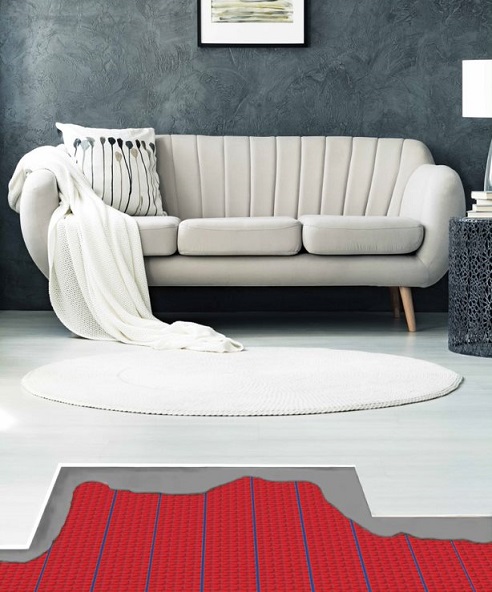When it comes to transforming your residence into a warm oasis during the frigid Bend or Portland, Oregon winters, radiant floor heating systems stand out as an impressive innovation. This article explores the many advantages of these systems, from the comfort and energy-efficiency they offer to the potential increase in property value.

We dive into the challenges of retrofitting existing homes, the regulatory considerations, and the unique potential of extending this heating solution to your garage, driveway, and walkways. With Warmup’s superior products and expertise, discover how you can transition to a cozier, safer, and more efficient living environment.
Understanding the Climates of Bend and Portland
Bend and Portland are both situated in the beautiful state of Oregon, and experience a variety of weather conditions throughout the year that affects their heating needs.
Bend
Bend, nestled east of the Cascade Range, boasts a high desert climate. This means it experiences warm, dry summers but frigid, snowy winters, making a reliable and efficient heating system an absolute necessity.
Portland
On the other hand, Portland’s climate is classified as Mediterranean, and enjoys warm, dry summers and cool, damp winters. With its fair share of cold and rainy days, Portland residents can greatly benefit from the consistent, comfortable warmth that radiant floor heating provides.
Given the climatic conditions of both Bend and Portland, radiant floor heating can be an excellent solution for maintaining a comfortable indoor environment year-round.
How Radiant Floor Heating Works

Radiant floor heating operates on the principle of heat transfer. In contrast to traditional heating systems that circulate warm air, radiant floor heating warms the room from the ground up – quite literally. Here’s how it works:
Heat Source – Whether it’s electric (via heated wires) or hydronic (via heated water), the heat source gets warmed up. In electric systems, the heating cables under your floor get powered by your home’s electricity. In hydronic systems, a boiler heats the water.
Heat Distribution – The warmed-up elements – either cables or water – then transmit this heat to the floor above. In essence, your entire floor becomes a large surface area for heat distribution that radiates upward.
Radiant Heat – The heat then radiates from the floor into the room heating the objects in the room, instead of the air. This means the heat is consistent and evenly distributed.
Types of Radiant Floor Heating Systems
Hydronic (Water-Based) Systems
These systems utilize a series of tubes, typically made of durable PEX tubing (though copper and iron pipe is also used), installed beneath the flooring. The tubes transport hot water from a boiler or water heater throughout your home, effectively turning your entire floor into a radiator. The heat from the hot water radiates upward from the floor, and warms the room evenly and provides a comfortable, consistent temperature.
Electric Systems
Electric radiant floor heating systems are another excellent choice, especially for smaller spaces or individual rooms. These systems utilize a network of electric cables installed beneath the floor, which, when powered, heat up and radiate warmth upward.
Comparison of Hydronic and Electric Systems
When comparing hydronic and electric radiant floor heating systems, both have their unique strengths and considerations that makes them suitable for different applications.
Efficiency
Hydronic systems are renowned for their energy efficiency, especially in larger spaces. The heat retention of the water means the system doesn’t need to be powered continuously for reduced energy consumption.
Electric systems, on the other hand, are quick to heat up and offer efficiency in smaller spaces.
Installation
Electric systems win in terms of ease and speed of installation. They are ideal for retrofit projects or for heating individual rooms, with minimal disruption during installation.
Hydronic systems require a more invasive installation, including the setup of a boiler or water heater, which makes them more suitable for new builds or major renovations.
Maintenance
Electric systems have fewer moving parts and no need for a boiler, which reduces the risk of failure and also reduces maintenance requirements.
Though they require more maintenance, hydronic systems have a long lifespan and can be a more robust solution for extended use.
Cost
Although hydronic systems may require a higher upfront investment due to their complex installation, they provide long-term cost savings.
Electric systems, while they may be more affordable and simpler to install, could potentially lead to higher energy expenses depending on the electricity rates in your specific location.
Both systems excel in providing a consistent, evenly distributed heat, for enhanced indoor comfort.
Advantages of Radiant Floor Heating
Energy Efficiency and Cost Savings
Unlike traditional heating systems that heat air, radiant floor heating warms the objects in a room directly, to reduce energy wastage and enhance overall efficiency. This results in substantial energy savings, which, over time, translates into lower heating bills.
Even and Consistent Heating
Unlike traditional heating systems, which can produce hot and cold spots due to uneven distribution of heat, radiant floor heating ensures a uniform temperature from floor to ceiling. By directly heating the floor surface, heat is dispersed evenly across the room, and the warmth naturally rises to create a comfortable environment throughout.
Improved Indoor Air Quality
Traditional heating systems circulate air around the room, which can distribute dust, allergens, and pathogens, potentially exacerbating respiratory conditions and allergies. In contrast, radiant floor heating operates silently and invisibly, to produce heat without stirring up air particles. This results in cleaner, healthier air within your home.
Design Flexibility and Space-Saving
Radiant floor heating systems are installed beneath the floor, which makes them invisible and allows homeowners to arrange furniture without limitations. This makes them perfect for contemporary, minimalist designs and rooms with large expanses of glass.
Reduced Noise Compared to Forced-air Systems
Forced-air systems often produce a noticeable amount of noise as they blow hot air through ducts and vents. Radiant floor heat is virtually silent. The absence of fans, blowers, or moving parts means that you won’t be disturbed by the constant hum or sudden start-stop noises common with traditional heating systems.
Radiant Floor Heating Installation Process
Pre-installation Considerations
Here are some important factors to consider for a successful and efficient setup:
Evaluate Space and Heating Needs: Calculate the total area to be heated and determine the system’s required output by performing a heat loss calculation.
Choosing a System: Decide between an electric or hydronic radiant heating system. Consider installation cost, operational cost, and system efficiency.
Compliance: Make sure your installation adheres to local building codes and regulations. Get the necessary permits before starting the work.
Professional Consult: Engage with professional installers or consultants to validate your design and implementation plans for optimized system performance.
Budgeting: Develop a comprehensive budget, considering system costs, installation, and any necessary floor modifications. Be sure to account for unexpected contingencies.
System Testing: Ensure all components are in working order before finalizing the installation.
By considering these factors, you can ensure a successful and efficient radiant floor heating system.
Flooring Types Suitable for Radiant Heat
Choosing the right flooring to pair with your radiant heating system is crucial for optimal performance and efficiency, so look for materials with high thermal conductivity to ensure efficient heat transfer. Let’s explore some common flooring types and how well they work with radiant heat
Tile and Stone: These materials are excellent choices due to their high thermal conductivity and heat retention properties.
Laminate and Vinyl: These flooring options are commonly used and compatible with radiant heat. Always check with the manufacturer for specific products suitable for this system.
Wood: Engineered wood is generally suitable, but solid wood may require checking for heat tolerance and potential impact on expansion and contraction.
Carpet: While it can be used, it’s important to ensure the carpet’s R-value is low to allow sufficient heat to pass through.
Insulation and Subfloor Requirements
Proper insulation and a suitable subfloor are crucial elements when installing radiant floor heating systems. They play a key role in maximizing system efficiency and ensuring your comfort in your Bend or Portland, Oregon home.
Insulation Material: Opt for high-quality insulation that prevents heat loss to the ground and directs it upward, for enhanced system efficiency.
R-Value: Make sure the insulation material has an appropriate R-value to minimize heat loss. Remember, the higher the R-value, the better the insulation.
Subfloor Material: Choose subfloor materials like cement board or plywood that can withstand the heat without warping or getting damaged.
Structural Integrity: Verify that the subfloor and overall floor structure can support the additional weight of the radiant heating system, including any concrete overlay and the new floor covering.
Barrier Installation: Consider including a moisture barrier underneath the insulation, especially on ground floors, to prevent potential damp issues.
By following these guidelines, you can ensure an approachable, informative, and practical approach to installing radiant floor heating systems.
Radiant Floor Heating Cost Considerations

Initial Installation Costs
The initial installation cost of a radiant floor heating system can vary greatly, depending on several factors.
Size of the Area: The cost of heating increases as the area to be heated gets larger.
Type of System: Hydronic systems, which use circulating warm water, are typically more expensive upfront than their electric counterparts due to the complexity of their components.
Flooring Material: Some flooring materials may require additional labor or specific installation methods, which could impact the overall cost.
Remember, while the initial installation cost might seem high, the comfort, efficiency, and potential energy savings of a radiant floor heating system make it a worthwhile investment for your home.
Operating Costs and Energy Savings
Running a radiant floor heating system can actually save you money. It’s a cost-effective option, especially when compared to traditional heating methods. The specific costs will vary based on factors like the size of the area you’re heating, the insulation of your home, and the electricity rates in your area.
Efficiency: Radiant floor heating systems distribute heat evenly throughout the room, to help ensure that no energy goes to waste. This helps reduce energy usage, which can lead to significant savings on your energy bills. For even greater efficiency, consider pairing the system with a Smart Thermostat.

Insulation: Proper insulation can greatly enhance the efficiency of your radiant heating system. By directing the heat upwards instead of letting it escape into the ground, your system will require less energy to maintain a comfortable temperature. Learn more about an insulated underlay to optimize your system’s performance.
Local Electricity Rates: Your local electricity rates will impact the operating cost of your system. While rates vary across locations, cities like Bend and Portland, tend to have competitive rates, which makes radiant floor heating an attractive option.
Return on Investment (ROI)
Investing in a radiant floor heating system isn’t merely about the immediate warmth and comfort you experience; it’s also about the long-term financial benefits.
Energy Savings: As we’ve mentioned, radiant floor heating is incredibly efficient. By directly heating the objects and people in a room rather than the air, these systems minimize energy wastage, leading to substantial savings on your energy bills over the years. Over time, these savings can offset the initial installation costs, thereby increasing your ROI.
Increased Property Value: Not to be overlooked is the increase in your property’s market value. Modern home buyers appreciate the luxurious comfort and efficiency of radiant floor heating, and are often willing to pay a premium for homes already equipped with these systems. This increase in property value can significantly improve your ROI when you decide to sell your home.
Reduced Maintenance Costs: Unlike traditional heating systems that may require regular maintenance or even costly repairs, radiant floor heating systems are remarkably low-maintenance. This translates into additional savings over the lifespan of the system, thereby further enhancing your ROI.
Longevity: Radiant floor heating systems are designed to last, which adds to their cost-effectiveness. With their robust construction and the absence of wear and tear common in mechanical systems, a one-time investment in radiant floor heating can serve you reliably for decades, thereby boosting your ROI.
Remember, while the upfront cost may be higher than traditional heating methods, considering the long-term benefits and the ROI, radiant floor heating becomes an exceptionally worthwhile investment for your home.
Environmental Benefits of Radiant Floor Heating
Energy Efficiency and Reduced Carbon Footprint
Radiant floor heating systems not only provide a warm and cozy living environment but also contribute to a reduced carbon footprint. These systems are highly energy-efficient, and use less electricity than traditional heating methods.
By directly warming the objects and people in a room instead of the air, radiant floor heating eliminates the inefficiencies associated with forced-air systems, where heat can easily escape. The result is a more efficient use of energy, and a reduction in your home’s overall electricity consumption, thereby lowering your carbon emissions.
Compatibility with Renewable Energy Sources
Radiant floor heating systems from Warmup are exceptionally compatible with renewable energy sources, to enhance their environmental benefits. These systems can easily integrate with solar panels or wind turbines, to provide efficient heating powered by renewable resources. By harnessing solar or wind energy, you can further reduce your reliance on grid electricity, decrease your carbon emissions and contribute to a more sustainable future.
Challenges and Considerations When Considering Radiant Floor Heating
Retrofitting Existing Homes with Radiant Floor Heating
Retrofitting your home with radiant floor heating involves several steps. First, assess your current flooring to determine the approach for installing the system. Next, choose between electric and hydronic systems based on your home’s needs. The installation process can be completed by a professional to minimize disruption.
While retrofitting can be more costly, the long-term benefits of comfort and energy efficiency make it a worthwhile investment. Consider radiant floor heating for a warm and efficient home in Bend or Portland.
Regulatory and Code Compliance
When considering radiant floor heating for your home, it’s essential to understand the local building codes and regulations. Here are key points to keep in mind:
Local Building Codes: Building codes differ depending on the location and may have specific guidelines for installing radiant floor heating.
Safety Standards: Safety is a top priority. Any radiant floor heating system should pass local and national safety standards.
Energy Efficiency Regulations: With an increasing focus on energy conservation, some regulations mandate the use of energy-efficient heating systems.
Radiant Floor Heating for Garages, Driveways, and Walkways

Radiant floor heating isn’t just for the interior of your home. It can also be used for your garage, driveway, and walkways, particularly during extreme winter weather conditions.
Garage Comfort: Do you utilize your garage as a workspace or recreational area? Radiant floor heating can convert your garage into a cozy, functional space, regardless of the winter chill.
Snow-free Driveways: Imagine not having to shovel snow off your driveway ever again. With a radiant heating system beneath your driveway, the snow melts away as it falls, to keep your driveway clear and safe.
Warm Walkways: Slippery, ice-covered walkways can pose a safety hazard. Radiant floor heating efficiently melts snow and ice, for safe, comfortable passage along your walkways.
Investing in a radiant floor heating system for your garage, driveways, and walkways offers tangible benefits. Beyond comfort and safety, it can enhance your property value and contribute to an environment-friendly lifestyle.
Work with Warmup for the Best in Radiant Floor Heating for Bend and Portland, Oregon
When it comes to radiant floor heating, Warmup stands as the leader in quality, innovation, and customer service. Possessing decades of experience in the industry, We offer a broad range of heating solutions tailored to meet the needs of your home or business.
We are your dedicated partner for radiant floor heating in Bend and Portland, Oregon. Our team of experts will guide you through the entire process, from understanding your heating needs to selecting the most suitable system and ensuring a seamless installation.
Contact us today for more information and a free quote!



